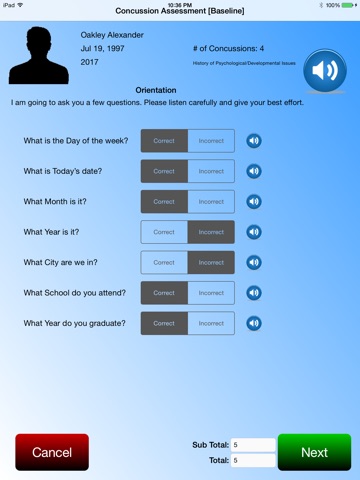
Designed in conjunction with the Head Trainer at an elite Liberal Arts College, the Concussion Assessment App is a valuable tool for trained medical personnel in the evaluation of head injuries.
Ideal for a school with multiple teams and large rosters, the Concussion Assessment provides for a Baseline Test to be recorded on each athlete . . . then performed again after an injury for comparison purposes. The medical personnel can then make an evaluation of the athlete’s ability to return to the competition.
The Concussions Assessment App Tests consists of:
• Repeating Random Words
• Counting Backwards
• Months of the Year Backwards
• Finger to Nose
• Rhomberg
• Valsalva
• Questions about Health
Complete with Graphics, Audio Directions and Timers . . . leading to a numerical score.
Baselines and Injury Scores can be viewed side-by-side; printed; e-mailed, Air Dropped and Messaged.
Optionally, the Concussion Assessment App supports the BESS (the Balance Error Scoring System), a standard way of assessing static postural stability. The BESS options similar Graphics, Audio Directions, Timers and numerical score . . . running through 7 screens of balance and coordination tests.
The Concussion Assessment App is not intended to replace trained medical professionals. If the athlete has lost consciousness, even briefly, call 911, contact an on-site EMT immediately or visit the emergency room:
Remember:
• All concussions are serious
• Most concussions occur without loss of consciousness.
• Recognition and proper response to concussions when they first occur can help prevent further injury or even death.
• When in doubt, sit them down!!!!
Other danger signs that should trigger a 911 call or emergency room visit:
• One pupil is larger than the other.
• Is drowsy or cannot be awakened
• Headache that gets worse and does no go away
• Weakness, numbness, or decreased coordination
• Repeated vomiting or nausea
• Slurred speech
• Convulsions or seizures
• Cannot recognize people or places
• Because increasingly confused, restless, or agitated
• Has unusual behavior
• Loses consciousness (even briefly)
• Will not stop crying/cannot be consoled
This is not a completed list and should not be considered as such. . . once again . . . When in doubt, sit them down . . . and see a trained medical professional (call 911, contact an on-site EMT, or visit the emergency room immediately).



